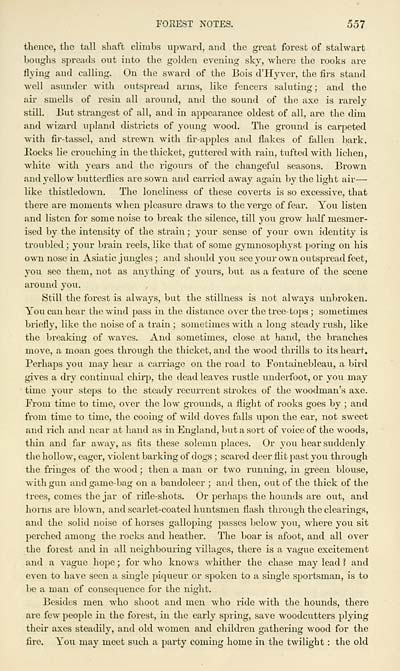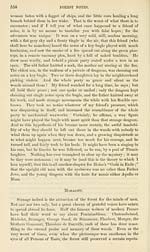Non-Fiction > Uncollected essays > Volumes 33-38, 1876-1878 - Cornhill magazine > Volume 33
(21) Page 557
Download files
Complete book:
Individual page:
Thumbnail gallery: Grid view | List view

FOREST NOTES. 557
thence, tlie tall shaft climbs ujiward, and tlie great forest of stalwart
houghs sj^reads out into the golden evening sky, where the rooks are
flying and calling. On the sward of the Bois d'Hyver, the firs stand
well asunder with ontspread arms, like fencers saluting; and the
air smells of resin all around, and the sound of the axe is rarely
still. But strangest of all, and in appearance oldest of all, are the dim
and wizard upland districts of young wood. The gi-ound is carpeted
with fir-tassel, and strewn with fir-apples and flakes of fallen bark.
Bocks lie croucliing in the thicket, guttered with rain, tufted with lichen,
white with years and the rigours of the changeful seasons. Brown
and yellow butterflies are sown and carried away again by the light air —
like thistledown. The loneliness of these coverts is so excessive, that
there are moments when jileasure draws to the verge of fear. You listen
and listen for some noise to break the silence, till you grow half mesmer-
ised by the intensity of the strain ; your sense of your own identity is
troubled ; your brain reels, like that of some gymnosophyst poring on his
own nose in Asiatic jungles ; and should you see your own outspread feet,
you see them, not as anything of yours, but as a feature of the scene
around you.
Still the forest is always, but the stillness is not always unbroken.
You can hear the wind pass in the distance over the tree-tops ; sometimes
briefly, like the noise of a train ; sometimes with a long steady rush, like
the breaking of waves. And sometimes, close at hand, the branches
move, a moan goes through the thicket, and the wood thrills to its heart.
Berhaps you may hear a carriage on the road to Fontainebleau, a bird
gives a dry continual chii'p, the dead leaves rustle underfoot, or you may
time your steps to the steady recurrent strokes of the woodman's axe.
From time to time, over the low grounds, a flight of rooks goes by ; and
from time to time, the cooing of wild doves falls upon the ear, not sweet
and rich and near at hand as in England, but a sort of voice of the woods,
thin and far away, as fits these solemn places. Or you hear suddenly
the hollow, eager, violent barking of dogs ; scared deer flit past you through
the fringes of the wood ; then a man or two running, in green blouse,
with gun and game-bag on a bandoleer ; and then, out of the thick of the
frees, comes the jar of rifle-shots. Or perhaps the hounds are out, and
horns are blown, and scarlet-coated huntsmen flash through the clearings,
and the solid noise of horses galloping passes below you, where you sit
perched among the rocks and heather. The boar is afoot, and all over
the forest and in all neighbouring villages, there is a vague excitement
and a vague hope ; for who knows whither the chase may lead 1 and
even to have seen a single piqueur or spoken to a single sportsman, is to
be a man of consequence for the night.
Besides men who shoot and men who ride with the hounds, there
are few people in the forest, in the early spring, save woodcutters plying
their axes steadily, and old women and children gathering wood for the
fire. You may meet such a party coming home in the twilight : the old
thence, tlie tall shaft climbs ujiward, and tlie great forest of stalwart
houghs sj^reads out into the golden evening sky, where the rooks are
flying and calling. On the sward of the Bois d'Hyver, the firs stand
well asunder with ontspread arms, like fencers saluting; and the
air smells of resin all around, and the sound of the axe is rarely
still. But strangest of all, and in appearance oldest of all, are the dim
and wizard upland districts of young wood. The gi-ound is carpeted
with fir-tassel, and strewn with fir-apples and flakes of fallen bark.
Bocks lie croucliing in the thicket, guttered with rain, tufted with lichen,
white with years and the rigours of the changeful seasons. Brown
and yellow butterflies are sown and carried away again by the light air —
like thistledown. The loneliness of these coverts is so excessive, that
there are moments when jileasure draws to the verge of fear. You listen
and listen for some noise to break the silence, till you grow half mesmer-
ised by the intensity of the strain ; your sense of your own identity is
troubled ; your brain reels, like that of some gymnosophyst poring on his
own nose in Asiatic jungles ; and should you see your own outspread feet,
you see them, not as anything of yours, but as a feature of the scene
around you.
Still the forest is always, but the stillness is not always unbroken.
You can hear the wind pass in the distance over the tree-tops ; sometimes
briefly, like the noise of a train ; sometimes with a long steady rush, like
the breaking of waves. And sometimes, close at hand, the branches
move, a moan goes through the thicket, and the wood thrills to its heart.
Berhaps you may hear a carriage on the road to Fontainebleau, a bird
gives a dry continual chii'p, the dead leaves rustle underfoot, or you may
time your steps to the steady recurrent strokes of the woodman's axe.
From time to time, over the low grounds, a flight of rooks goes by ; and
from time to time, the cooing of wild doves falls upon the ear, not sweet
and rich and near at hand as in England, but a sort of voice of the woods,
thin and far away, as fits these solemn places. Or you hear suddenly
the hollow, eager, violent barking of dogs ; scared deer flit past you through
the fringes of the wood ; then a man or two running, in green blouse,
with gun and game-bag on a bandoleer ; and then, out of the thick of the
frees, comes the jar of rifle-shots. Or perhaps the hounds are out, and
horns are blown, and scarlet-coated huntsmen flash through the clearings,
and the solid noise of horses galloping passes below you, where you sit
perched among the rocks and heather. The boar is afoot, and all over
the forest and in all neighbouring villages, there is a vague excitement
and a vague hope ; for who knows whither the chase may lead 1 and
even to have seen a single piqueur or spoken to a single sportsman, is to
be a man of consequence for the night.
Besides men who shoot and men who ride with the hounds, there
are few people in the forest, in the early spring, save woodcutters plying
their axes steadily, and old women and children gathering wood for the
fire. You may meet such a party coming home in the twilight : the old
Set display mode to: Large image | Transcription
Images and transcriptions on this page, including medium image downloads, may be used under the Creative Commons Attribution 4.0 International Licence unless otherwise stated. ![]()
| Early editions of Robert Louis Stevenson > Non-Fiction > Uncollected essays > Cornhill magazine > Volume 33 > (21) Page 557 |
|---|
| Permanent URL | https://digital.nls.uk/78692685 |
|---|
| Dates / events: |
1876 [Date/event in text] |
|---|---|
| Subject / content: |
Volumes (documents by form) |
| Person / organisation: |
Stevenson, Robert Louis, 1850-1894 [Contributor] |
| Form / genre: |
Written and printed matter > Periodicals |
|---|---|
| Dates / events: |
1860-1975 [Date published] |
| Places: |
Europe >
United Kingdom >
England >
Greater London >
London
(inhabited place) [Place published] |
| Subject / content: |
Fiction Journals (periodicals) Short stories |
| Person / organisation: |
Smith, Elder, and Co. [Publisher] |
| Description | Essays and reviews from contemporary magazines and journals (some of which are republished in the collections). 'Will o' the Mill', from Volume 37 of the 'Cornhill Magazine', is a short story or fable. |
|---|
| Person / organisation: |
Stevenson, Robert Louis, 1850-1894 [Author] |
|---|



